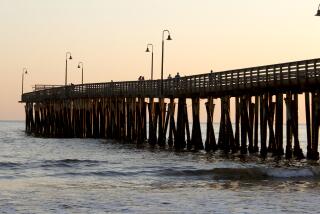Central Coast Land Set Aside as Greenbelt
- Share via
LOS OSOS, Calif. — The Trust for Public Land announced plans to purchase property in the heart of this seaside town on the Central Coast, as part of a continuing effort to create a greenbelt around the scenic southern side of Morro Bay.
Working with a host of governmental and private groups, the land trust, along with the Morro Estuary Greenbelt Alliance, has purchased 40 more acres for the greenbelt at a cost of $1.5 million. The trust then transferred the land to the state to become part of Morro Bay State Park.
Plans call for an eventual 1,000-acre corridor stretching from Montana de Oro State Park to Morro Bay State Park to form a horseshoe around Los Osos, an unincorporated community of 14,800. Three hundred acres have been acquired since the plan for the San Luis Obispo County property was launched in 1997.
Started more than 80 years ago as a coastal fishing and hunting retreat for residents of the hot Central Valley, Los Osos is a haphazardly planned coastal enclave perched on dunes. Sand blows across the town’s paved and unpaved roads on windy days.
Many of today’s lots in Los Osos can be traced to 1919, when two developers advertised 25-foot wide lots in the town for $400 in a national edition of Popular Mechanics magazine. They started as early tent sites, and later housed fishing shacks. Now, many of the same small lots contain $400,000-plus homes.
As preservation efforts have moved closer to Los Osos, environmentalists are buying expensive property often zoned residential, according to Mary Menees with the Trust for Public Land. The newly acquired acreage sits beside homes in this coastal town.
“It’s vitally important if you want to see this area avoid the same sprawl which has taken over places like Los Angeles,” Menees said. She said her organization is putting an increased emphasis on the California Central Coast, because of its potential for protecting species and habitat lost in other regions of the state.
Marla Morrissey, with the Greenbelt Alliance, said, “Coastal dunes around the world are more rare than the rain forest and under more pressure [of] being lost to development.”
This news comes at a significant time for those worried about the future of the area. Los Osos, under a state-mandated 14-year building moratorium because of its failure to build a sewage plant, still relies on septic systems. But as plans have been finalized to break ground for a sewer plant, expected to cost $106 per lot per month, some residents worry about how fast the community might grow upon its completion.
Malibu similarly fought sewers -- even incorporating, in part, over the issue -- in hopes of staving off development.
The 40 acres that make up the latest purchase are adjacent to Los Osos Middle School.
Annemarie Vallesteros is the school’s seventh-grade science teacher, and she has incorporated the dunes into her classes. Students pull out nonnative African veldt grass and plant silver dune lupine seedlings.
“The entire life cycle of the Morro Bay Blue Butterfly depends on silver dune lupine,” Vallesteros explained. The butterfly is listed as threatened on the federal Endangered Species List.
“Usually, middle school is a blur,” Vallesteros said. “But most of these kids can tell you what they did in the dunes and why they did it. That’s an accomplishment.”
More to Read
Sign up for Essential California
The most important California stories and recommendations in your inbox every morning.
You may occasionally receive promotional content from the Los Angeles Times.










